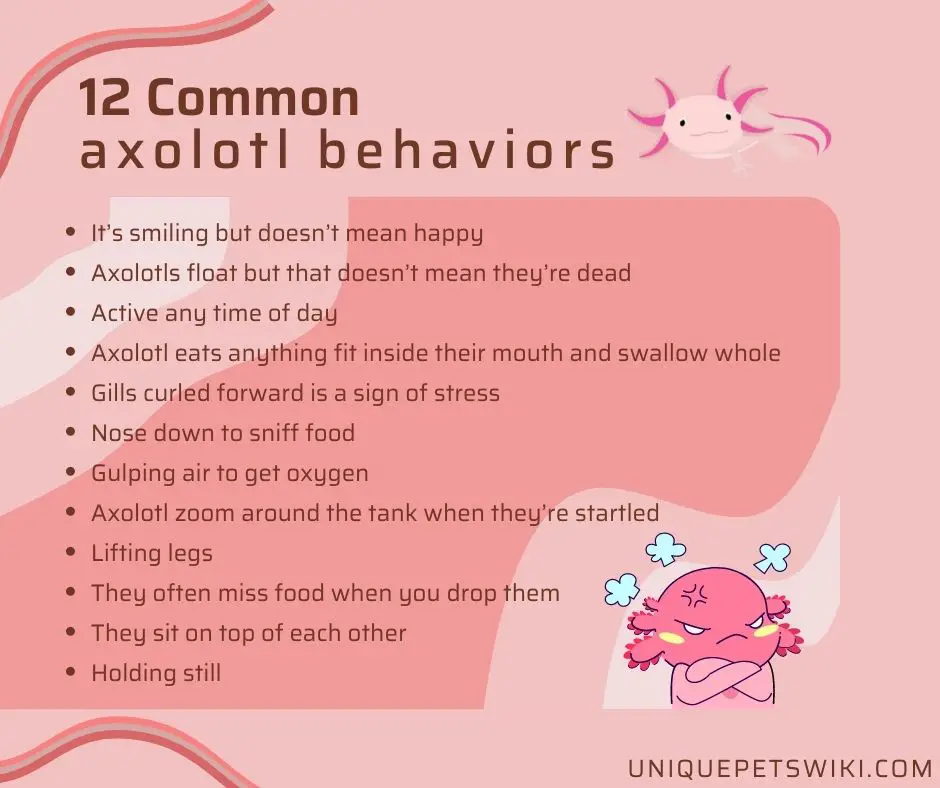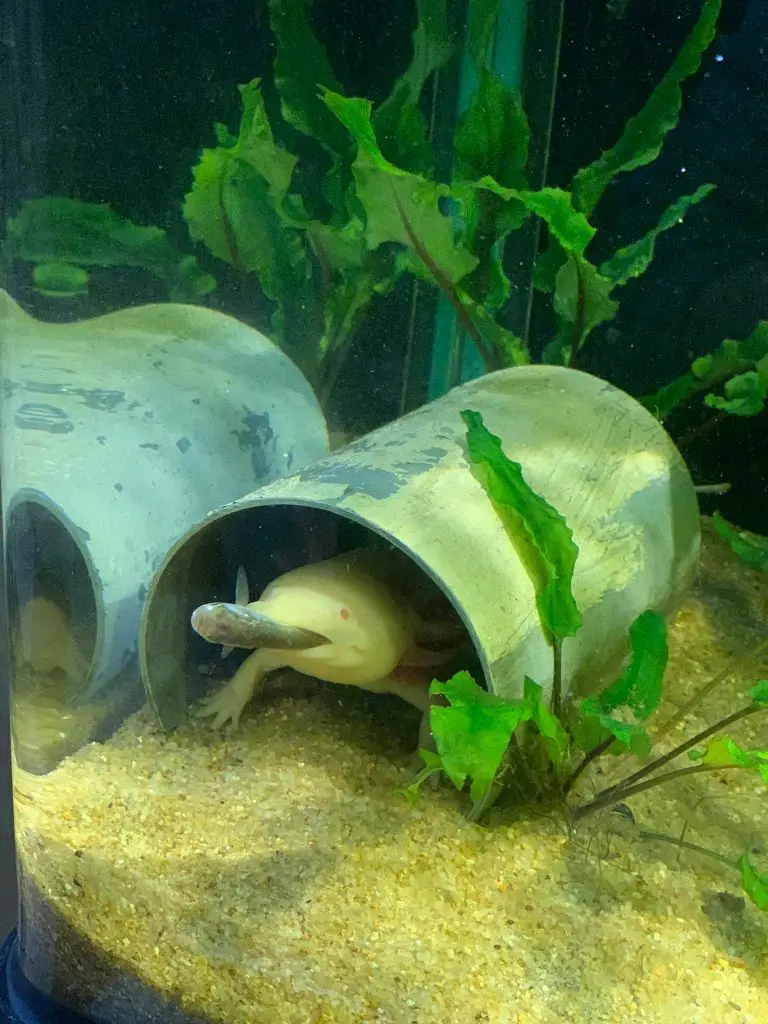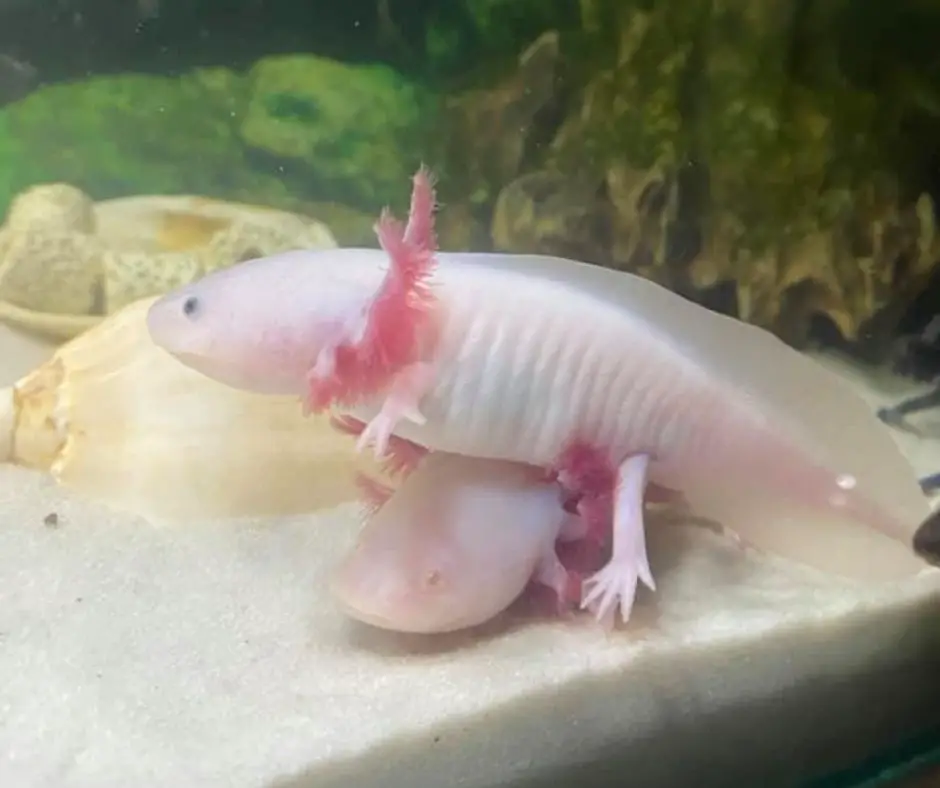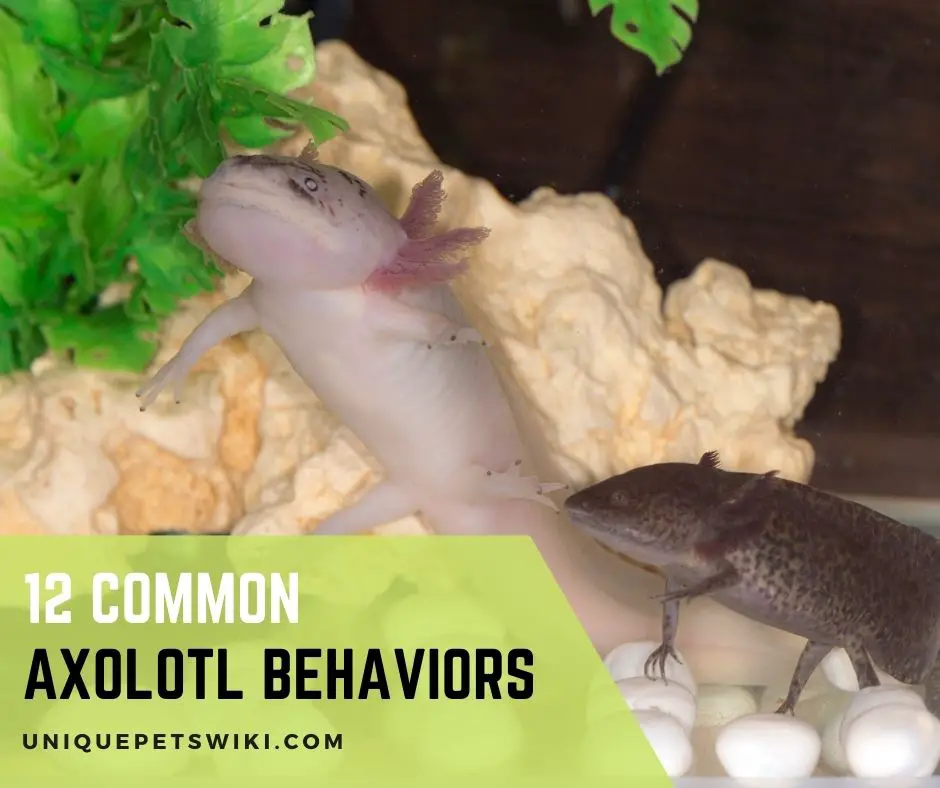Axolotls are cute animals to have in your aquarium. Apart from their beauty, they are easy to maintain and feed. However, you should understand its behavior to respond appropriately.
Axolotls behave differently depending on the situation and other factors. If you don’t understand what they mean, you can be confused to think they are dead, sick, or something like that. Don’t be caught off-guard.
This article focuses on the 12 most common axolotl behaviors that every pet owner should know. Continue reading for detailed information.
Contents
- 12 Common Axolotl Behaviors
- It’s Smiling But Doesn’t Mean Happy
- Axolotls Float But That Doesn’t Mean They’re Dead
- Active Any Time of Day
- Axolotl Eats Anything Fit Inside Their Mouth and Swallow Whole
- Gills Curled Forward Is a Sign of Stress
- Nose Down to Sniff Food
- Gulping Air to Get Oxygen
- Axolotl Zoom Around the Tank when They’re Startled
- Lifting Legs
- They Sit on Top of Each Other
- They Often Miss Food When You Drop Them
- Holding Still
- Uncommon Axolotl Behaviors
- Conclusion
12 Common Axolotl Behaviors
How much do you understand about your axolotl pet? Axolotls can be kept by experienced and novice pet owners, but responding to their call is not optional. You need to know what every behavior means.
Axolotls have so many behaviors that we cannot mention all of them. But we will talk about the most common ones, such as smiling, floating on water, being active during the day, eating anything possible, and curling gills forward. Let’s get into the details of each.

It’s Smiling But Doesn’t Mean Happy
This can look strange to new pet owners, who misunderstand it often. Due to the nature of their mouths, axolotls seem to be smiling many times. Don’t interpret that as a sign of happiness.
After the axolotls swallow their chunks, they wear a smiling pose for a few seconds. They have slightly upturned mouths that look more like a smile. However, the truth is that it is a usual gesture in axolotls. People often associate it with a smile and a sign of happiness but far from the truth.
A happy axolotl leaves its gills to float freely in water, move around the aquarium, eat, and look healthy. Find more information on how to identify a happy axolotl to never mistake their usual smile for happiness.
Learn more: how to tell if your axolotl is happy
Axolotls Float But That Doesn’t Mean They’re Dead
Axolotls can float on water for fun. Don’t panic, thinking that something is wrong or it is dead. That can be so, but let’s explain a few facts.
An axolotl floats on water for fun, but that should last a few minutes. And if you scare it, it will quickly descend to the bottom of the tank. Also, if they take in air, they may be forced to float for a longer time. However, the behavior can also result from health and water conditions.
Bloating, impaction and excess ammonia in the water are the most common causes of floating in axolotls. Axolotls can swallow air bubbles from a bubbler or when eating. They also suffer from stomach upsets.
These can cause bloating. A bloated axolotl floats on water with its back on the water surface.
Axolotls floating on water does not mean it is dead, but the behavior is deadly and requires an immediate response. Get more information on the causes and remedies if axolotls float on water.
Active Any Time of Day
Axolotls are most active at dusk and night. They spend most of their time sleeping at the bottom of the tank or in their favorite corner. As they become old, they become less and less active.
However, some are just more active than others. So, what you should be looking at is the abrupt behavior change.
If your axolotls are overly active or restless, it is a sign of a problem in the environment or health. Poor water quality, high water pH and temperature, broken nitrogen cycle, and diseases are common causes. Also, a powerful filter can make them restless.
You should understand that axolotls are nocturnal animals that will stay active at night and spend most of the daytime hiding. If that happens during the day, check the possible reason and resolve the problem.
Axolotl Eats Anything Fit Inside Their Mouth and Swallow Whole
This is a normal behavior in axolotls, and there is no need to worry. Their dental systems are not well-developed for tearing their prey into pieces. Teeth are only for holding and not for chewing.
That means they will swallow anything that fits in their mouth whole. Unfortunately, this behavior can make axolotls eat even the gravel at the bottom of the tank.
As a pet owner, ensure the food chunks you give your axolotls are of the right sizes that fit into their mouths. Secondly, don’t use large gravels in your aquarium. If you are not sure about the size, just avoid them altogether. Swallowing gravels can cause compaction.
check out this article: What can axolotl eat?

Gills Curled Forward Is a Sign of Stress
There are many signs of stress in axolotls, but gills curling forward are the most apparent. This behavior is not common if you keep them happy. But if they get stressed often, you will also see the behavior as often.
Gills bending forward or curling forward results from stress caused by the environment. If there are strong water currents or increases in ammonia levels, your axolotls are likely to show this behavior.
Check the tank water for the mentioned conditions and take appropriate action as soon as possible to save your axolotls. Continued stressful conditions can affect their health.
API Water Test Kit
- Contains one (1) API FRESHWATER MASTER TEST KIT 800-Test Freshwater Aquarium Water Master Test Kit, including 7 bottles of testing solutions, 1 color card and 4 glass tubes with cap
- Helps monitor water quality and prevent invisible water problems that can be harmful to fish and cause fish loss
- Accurately monitors 5 most vital water parameters levels in freshwater aquariums: pH, high range pH, ammonia, nitrite, nitrate
- Designed for use in freshwater aquariums only
- Use for weekly monitoring and when water or fish problems appear
Last update on 2022-12-30 / Affiliate links / Images from Amazon Product Advertising API
Nose Down to Sniff Food
Nose down is a usual behavior in axolotls when finding food at the bottom of the tank. They do this while standing, head tilted, and sometimes moving around the tank. You will realize their improved focus.
Axolotls will have their nose down when looking around for food. It can be a tasty worm or a delicious pellet.
They generally have poor sight and depend on smell and movement to locate prey. So, unless they concentrate, they might miss the food altogether. If you are feeding an axolotl a dead worm, consider dongling it for it to see.
Gulping Air to Get Oxygen
Gulping for air is a common behavior in axolotls. It is part of their respiration that should not worry you at all. This procedure begins at the bottom of the tank. From the resting position, axolotls suddenly ascend to the water surface.
Upon reaching the top, it grabs a gulp and dives back to the bottom of the tank. This occasionally occurs and is normal behavior. Axolotls have lungs and need to gulp air.
Axolotls going up for air can become very frequent if the water quality deteriorates. Check the oxygen and ammonia levels.
UPETTOOLS Aquarium Air Pump Ultra Silent
- 💤ULTRA SILENCE - Newest version Aquarium air pump Hpumps is the smallest and the most silent pump in the world. Ultra quiet, Sound less than 35dB.
- 💤 LOW POWER CONSUMPTION - Power consumption of this oxygen pump is only 1W, with flow rate 450 ml/min, high energy saving.
- 💤 STABLE PERFORMANCE - Oxygen air pump is stable performance, is ideal for small and medium-sized fish tank plus oxygen. It is also perfectly suitable for using at all kinds of high-grade aquarium, aquaculture oxygenation or spout decoration
- 💤SAVE SPACE - It is made of premium material. It can suck on the tank wall, doesn't take up space.
- 💤EASY TO USE - Our silent aquarium air pump is very easy to install, connect filter air stone and silicone tube with pump outlet, then Hang the air pump on the tank wall, immerse air stone into fish tank. As a gift for family and friends.
Last update on 2022-12-29 / Affiliate links / Images from Amazon Product Advertising API
Axolotl Zoom Around the Tank when They’re Startled
Axolotls zooming around the tank is okay in many cases. It can mean they are active or startled, especially when you switch on the lights in the room or something else is getting their attention.
Young axolotls are more energetic and swim around the tanks more frequently than adults. They will move quickly to the top to gulp air and come back down.
However, zooming can also mean something is wrong in the water chemistry. If the behavior lasts more than a few seconds, check the ammonia, oxygen, and water temperature. Strong currents or impulses can also startle them. Just ensure everything is normal for the usual zooming.
Lifting Legs
Axolotls lift their legs at angles for various reasons, but it is nothing to worry about. The behavior is expected in these amphibians. In most cases, they use it to communicate.
If axolotls are only lifting their back legs, it shows they are about to have a bowel movement. But lofting front legs is an act of balancing on something. That simply means they are excited and playful.
The last reason your axolotls lift their legs is to express their mating desires. You will miss this behavior if your aquarium has only females. It is common for males to allow them to leave a sperm cone. Females may not show it if they don’t share a tank with males.
If not for the stated reasons, your axolotls will never raise their legs.
They Sit on Top of Each Other
Axolotls are lonely animals that thrive well without companionship. But you can be surprised if your two axolotls come close together or even sit on top of each other. This is normal, and you have nothing to worry about.
However, ensure they are well-fed, are of the same size, and have plenty of space in the tank. You may also consider gender.
Often, axolotls of the same gender get along with each other than male and female. The only time you should worry is when you feed them. Just ensure they are a part to avoid unnecessary injuries.

They Often Miss Food When You Drop Them
This happens a lot in axolotls. They can miss spotting the food that you drop in the tank. It may be your first hilarious interaction with axolotls if they can’t just find it right in front of them.
Axolotls have poor eyesight and rely on smell and movements. The best thing you can do is dangle the worm right in front of them.
Also, don’t let any unnoticed food rot in your aquarium. It will increase the ammonia levels and compromise the water quality. Just remove them and try again.
Holding Still
Axolotls will rest most times of the day. That is their nature and is normal. As they get older, their physicality drops even further. This should not worry you if there are no other associated symptoms.
Being predatory animals, axolotls may stand still waiting for prey to pass by to ambush. Just observe it for some time before you can take any action.
Uncommon Axolotl Behaviors
Axolotls behave differently. Some may surprise you when they pull out a unique behavior. The following are some of the weirdest axolotl behaviors:
Release Gas From The Back End
Axolotls can have floating issues if they have excess gas in their system. That is why they may release excess through the back end to allow them to swim freely through the tank from top to bottom.
Can Change Color
This might come as a surprise, but it is the truth. Axolotls naturally change color to match the environmental and developmental factors. This camouflaging is needed to hunt and avoid predators. They also change gill color depending on activity level and feeding time.
Can’t Find Food
Pellets or warms can go unnoticed at the bottom of the tank. Your axolotls can just be looking around and fail to spot it. That is due to their poor eyesight.
Conclusion
You now know the behaviors you expect from this little cute pet. Some may be uncommon and brought about by stressful conditions. If you keep your axolotls happy, you may miss seeing some of these behaviors. But what is important is acting quickly for some that need your attention.
Thank you for reading this article at Petsive. We appreciate your time, and we invite you to explore other related content. Also, please share it with other pet lovers.


